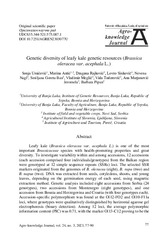Genetic diversity of leafy kale genetic resources (Brassica oleracea var. acephala L.)
Genetički diverzitet genetičkih resursa raštana (Brassica oleracea var. acephala L.)
| dc.creator | Umićević, Sonja | |
| dc.creator | Antić, Marina | |
| dc.creator | Rajković, Dragana | |
| dc.creator | Sinkovič, Lovro | |
| dc.creator | Nagl, Nevena | |
| dc.creator | Goreta Ban, Smiljana | |
| dc.creator | Meglič, Vladimir | |
| dc.creator | Todorović, Vida | |
| dc.creator | Marjanović-Jeromela, Ana | |
| dc.creator | Pipan, Barbara | |
| dc.date.accessioned | 2023-10-09T10:42:33Z | |
| dc.date.available | 2023-10-09T10:42:33Z | |
| dc.date.issued | 2023 | |
| dc.identifier.issn | 1512-6412 | |
| dc.identifier.issn | 2233-0070 | |
| dc.identifier.uri | http://fiver.ifvcns.rs/handle/123456789/3784 | |
| dc.description.abstract | Leafy kale (Brassica oleracea var. acephala L.) is one of the most important Brassicaceae species with health-promoting properties and great diversity. To investigate variability within and among accessions, 12 accessions (each accession comprised four individuals/genotypes) from the Balkan region were genotyped at 12 simple sequence repeats (SSRs) loci. The selected SSR markers originated from the genomes of B. oleracea (eight), B. rapa (two) and B. napus (two). DNA was extracted from seeds, cotyledons, shoots, and young leaves, depending on the germination energy of each seed, using magnetic extraction method. Genetic analysis included eight accessions from Serbia (24 genotypes), two accessions from Montenegro (eight genotypes), and one accession from Bosnia and Herzegovina and Croatia (with four genotypes each). Accession-specific polymorphism was found at the Ol12-FO2 and Ol10-F11a loci, where genotypes were qualitatively distinguished by horizontal agarose gel electrophoresis (binary detection). Among 12 loci, the average polymorphic information content (PIC) was 0.71, with the marker Ol13-C12 proving to be the 78 Umićević et al. most informative (PIC = 0.89). However, the analysis of molecular variability (AMOVA) showed 11% diversity between accessions, 19% diversity between genotypes, and 70% diversity within genotypes, explaining the molecular diversity of native Balkan leafy kale germplasm. According to the genetic structure, four genetic groups were formed with an average expected heterozygosity of 0.70 between clusters. In order to exploit the genetic diversity, it would be advisable to evaluate these accessions at phenotypic level and use their potential in breeding programmes. | sr |
| dc.description.abstract | Raštan (Brassica oleracea var. acephala L.) je jedna od najvažnijih vrsta iz porodice kupusnjača koja povoljno utiče na zdravlje ljudi i odlikuje se velikom raznovrsnošću. Da bi se istražila varijabilnost unutar i između prinova, 12 prinova (svaka prinova se sastojala od četiri individue/genotipa) sa teritorije Balkanskog poluostrva je genotipizovano koristeći 12 SSR markera. Odabrani SSR markeri potiču iz genoma B. oleracea (osam), B. rapa (dva) i B. napus (dva). DNK je izolovana iz sjemena, kotiledona, izdanaka i mladih listova, u zavisnosti od energije klijanja svakog sjemena, metodom magnetne ekstrakcije. Genetičkom analizom obuhvaćeno je osam prinova iz Srbije (24 genotipa), dvije prinove iz Crne Gore (osam genotipova) i jedna prinova iz Bosne i Hercegovine i Hrvatske (sa po četiri genotipa). Polimorfizam specifičan za prinove pronađen je na lokusima Ol12-FO2 i Ol10-F11a, gdje su genotipovi kvalitativno razlikovani horizontalnom elektroforezom u agaroznom gelu (binarna detekcija). Kod ukupno 12 lokusa, prosječan sadržaj polimorfne informacije (PIC) bio je 0,71, pri čemu se kao najinformativniji pokazao marker Ol13-C12 (PIC = 0,89). Međutim, analiza molekularne varijabilnosti (AMOVA) pokazala je 11% raznovrsnosti između prinova, 19% raznovrsnosti između genotipova i 70% raznovrsnosti unutar genotipova, objašnjavajući molekularnu raznovrsnost izvorne germplazme raštana sa teritorije Balkanskog poluostrva. Prema genetičkoj strukturi formirane su četiri genetičke grupe sa prosječnom očekivanom heterozigotnošću od 0,70 između klastera. Da bi se iskoristio genetički diverzitet, bilo bi preporučljivo da se ove prinove karakterišu 90 Umićević et al. na fenotipskom nivou i da se njihov potencijal iskoristi u programima oplemenjivanja. | sr |
| dc.language.iso | en | sr |
| dc.publisher | Banja Luka : University of Banja Luka, Faculty of Agriculture | sr |
| dc.relation | Bilateral project Slovenia - Serbia (ARRS-BI-BS/20-21-015) | sr |
| dc.relation | Bilateral project Slovenia - Bosnia and Herzegovina (ARRS-BI-BA/21-23-011) | sr |
| dc.relation | Slovenian Research Agency (ARRS) | sr |
| dc.relation | EUBRASWILD project under the sixth call of the ECPGR Activity Grant Scheme (First Call – Phase X, 2019-2023) | sr |
| dc.rights | openAccess | sr |
| dc.rights.uri | https://creativecommons.org/licenses/by/4.0/ | |
| dc.source | Agroznanje / Agro-knowledge Journal | sr |
| dc.subject | leafy kale | sr |
| dc.subject | accession | sr |
| dc.subject | genetic analysis | sr |
| dc.subject | SSR | sr |
| dc.subject | genotyping | sr |
| dc.subject | raštan | sr |
| dc.subject | prinova | sr |
| dc.subject | genetička analiza | sr |
| dc.subject | genotipizacija | sr |
| dc.subject | genetički resursi | sr |
| dc.title | Genetic diversity of leafy kale genetic resources (Brassica oleracea var. acephala L.) | sr |
| dc.title | Genetički diverzitet genetičkih resursa raštana (Brassica oleracea var. acephala L.) | sr |
| dc.type | article | sr |
| dc.rights.license | BY | sr |
| dc.citation.epage | 90 | |
| dc.citation.issue | 3 | |
| dc.citation.spage | 77 | |
| dc.citation.volume | 24 | |
| dc.identifier.doi | 10.7251/AGREN2303077U | |
| dc.identifier.fulltext | http://fiver.ifvcns.rs/bitstream/id/9617/bitstream_9617.pdf | |
| dc.type.version | publishedVersion | sr |


